Eastern wood-peewee (Contopus virens)
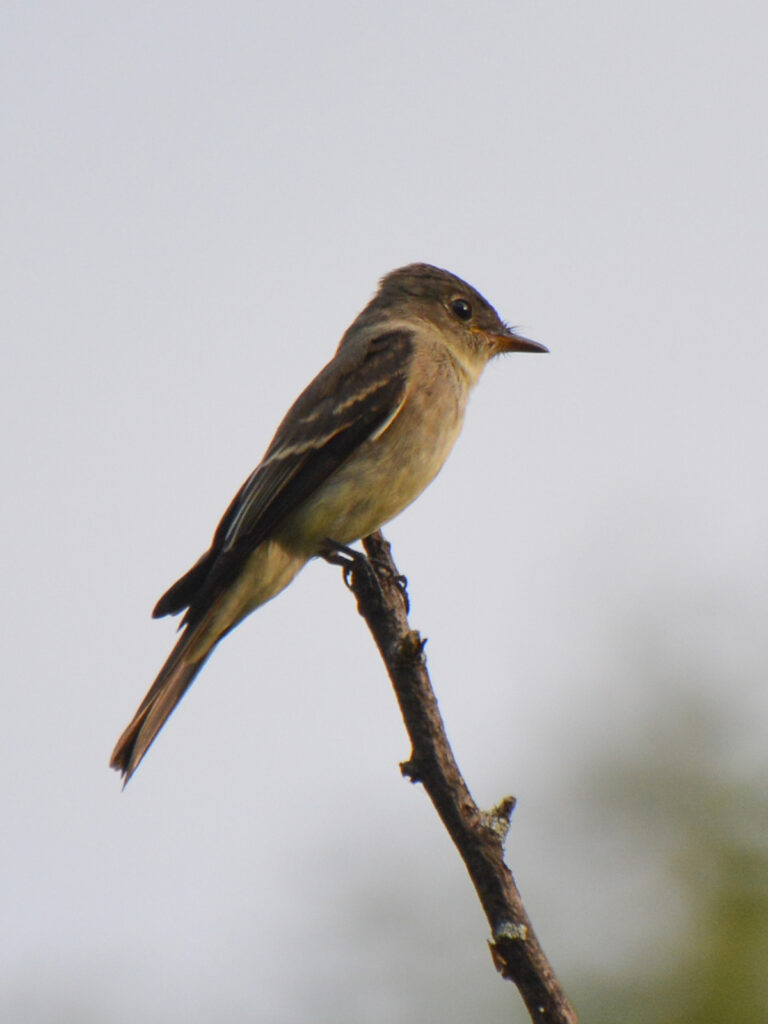
I think he was just passing through our yard. I was lucky to be able to snap its picture before he left.
- Learn more:
- Cornell’s All About Birds: Eastern wood-peewee
| YR | J | F | M | A | M | J | J | A | S | O | N | D |
| 24 | · | |||||||||||
| 23 | · | · | · | · | · | · | · | · | ||||
| 22 | · | · | · | · | · | · | · | · | · | |||
| 21 | · | · | · | · | · | · | · | · | · | · | · | |
| 20 | · | · | · | · | · | · | · | · | · | · | ||
| 19 | · | · | · | · | · | · | · | · | · | |||
| 18 | · | · | · | · | · | · | · | · | · | |||
| 17 | · | · | · | · | · | · | · | · | · | · | ||
| 16 | · | · | · | · | · | · | · | · | · | |||
| 15 | · | · | · | · | · | 1 | · | · | · | |||
| 14 | · | · | · | · | · | · | · | · | · | |||
| 13 | · | · | · | · | · | · | · | · | · | |||
| 12 | · | · | · | · | · | · | · | · | · | |||
| 11 | · | · | · | · | · | · | · | · | · | · | · | |
| 10 | · | · | · | · | · | · | · | · | · | · | · | |
| 09 | · | · | · | · | · | · | · | · | · | · | · | |
| 08 | · | · | · | · | · | · | · | · | · | · | · | |
| 07 | · | · | · | · | · | · | · | · | · | · | · | |
| 06 | · | · | · | · | · | · | · | · | · | · | · | · |
| 05 | · | · | · | · | · | · | · | · | · | · | · | · |
| 04 | · | · | · | · | · | · | · | · | · | · | · | · |
| 03 | · | · | · | · | · | · | · | · | · | · | · | · |
| 02 | · | · | · | · | · | · | · | · | · | · | · | · |
| 01 | · | · | · | · | · | · |
Eastern phoebe (Sayornis phoebe)
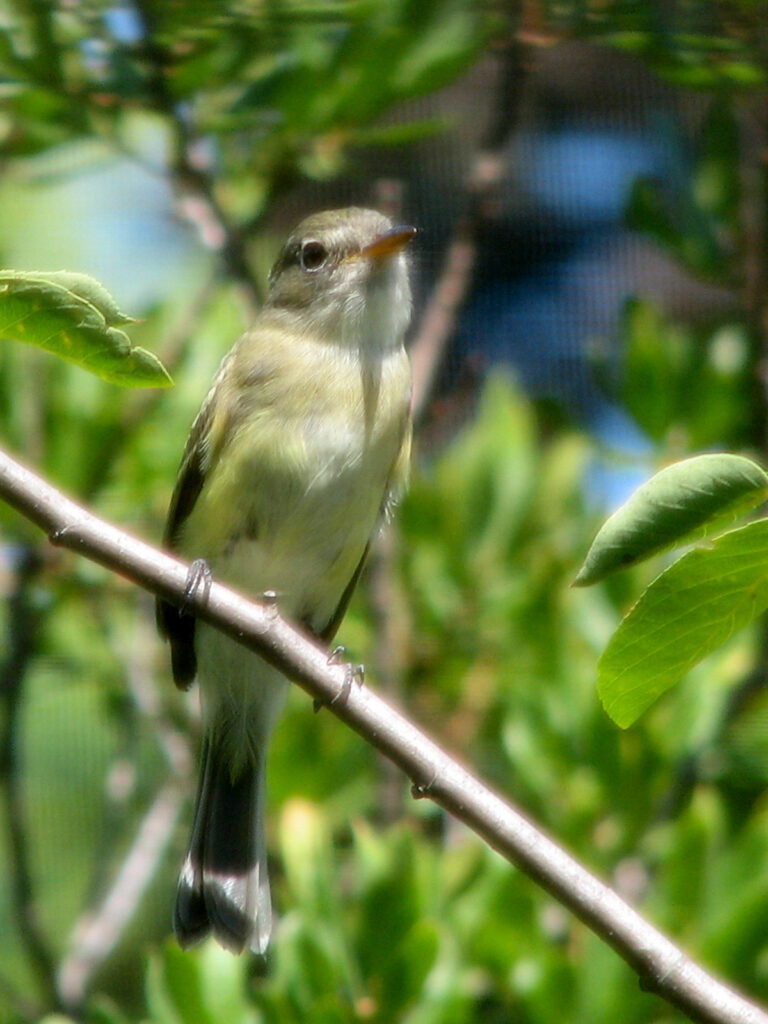
We haven’t seen this bird very often. This photo is taken through the porch screen since like so many other birds, it enjoys all the shrubbery around the porch.
- Learn more:
- Cornell’s All About Birds: Eastern phoebes
- American Bird Conservancy: Bird of the Week
- Cool Green Science: Meet the Eastern phoebe, the flycatcher that coexists with humans
- Bird Watcher’s General Store: Eastern phoebes
| YR | J | F | M | A | M | J | J | A | S | O | N | D |
| 24 | · | |||||||||||
| 23 | · | 1 | · | · | · | · | · | · | ||||
| 22 | · | · | · | · | · | · | · | · | · | |||
| 21 | · | · | · | · | · | · | · | · | · | · | · | |
| 20 | · | · | · | · | · | · | · | · | · | · | ||
| 19 | 1 | · | 1 | · | · | · | · | · | · | |||
| 18 | · | · | · | · | · | · | · | · | · | |||
| 17 | · | · | · | · | · | · | · | · | · | · | ||
| 16 | · | · | · | · | · | · | · | · | · | |||
| 15 | · | · | · | · | · | · | · | · | · | |||
| 14 | · | · | · | · | · | · | · | 1 | · | |||
| 13 | · | · | · | · | · | · | · | · | · | |||
| 12 | · | · | · | · | · | 1 | · | · | · | |||
| 11 | · | · | · | · | · | · | · | · | · | · | · | |
| 10 | · | · | · | · | · | · | · | · | · | · | · | · |
| 09 | · | · | · | · | · | · | · | · | · | · | · | · |
| 08 | · | · | · | · | · | · | · | · | · | · | · | · |
| 07 | · | · | · | · | · | · | · | · | · | · | · | · |
| 06 | · | · | · | · | · | · | · | · | · | · | · | · |
| 05 | · | · | · | · | · | · | · | · | · | · | · | · |
| 04 | · | · | · | · | · | · | · | · | · | · | · | · |
| 03 | · | · | 1 | · | · | · | · | · | · | · | · | · |
| 02 | · | · | · | · | · | · | · | · | · | · | · | · |
| 01 | · | · | · | · | · | · |
Great crested flycatcher (Myiarchus crinitus)
The same week I saw the Eastern kingbird for the first time, I saw this flycatcher for the first time. His yellow breast topped with gray was just as striking as the kingbird’s white breast. He spent some time getting gray dogwood berries.
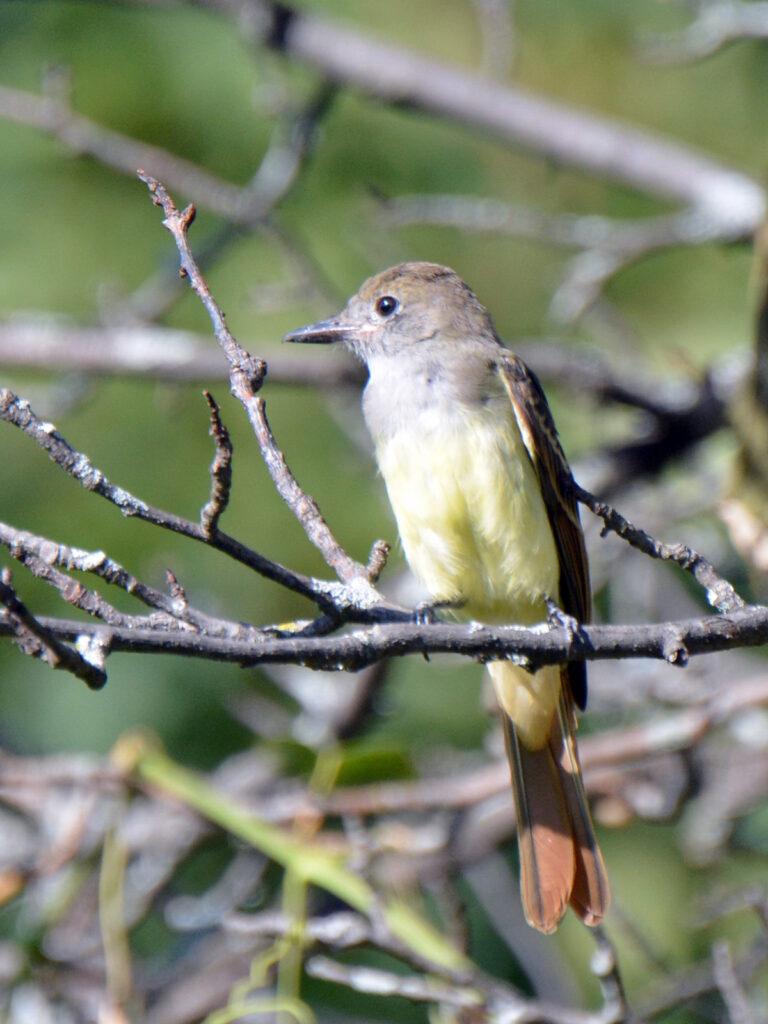
- Learn more:
- Cornell’s All About Birds: Great crested flycatcher
- American Bird Conservancy: Bird of the Week
| YR | J | F | M | A | M | J | J | A | S | O | N | D |
| 24 | · | |||||||||||
| 23 | · | · | · | · | · | · | · | · | ||||
| 22 | · | · | · | · | · | · | · | · | · | |||
| 21 | · | · | · | · | · | · | · | · | · | · | · | |
| 20 | · | · | · | · | · | · | · | · | · | · | ||
| 19 | · | · | · | · | · | · | · | · | · | |||
| 18 | · | · | · | · | · | · | · | · | · | |||
| 17 | · | · | · | · | · | · | · | · | · | · | ||
| 16 | · | · | · | · | · | · | · | · | · | |||
| 15 | · | · | · | · | 1 | 1 | 1 | · | · | |||
| 14 | · | · | · | · | · | · | · | · | · | |||
| 13 | · | · | · | · | · | · | · | · | · | |||
| 12 | · | · | · | · | · | · | · | · | · | |||
| 11 | · | · | · | · | · | · | · | · | · | · | · | |
| 10 | · | · | · | · | · | · | · | · | · | · | · | · |
| 09 | · | · | · | · | · | · | · | · | · | · | · | · |
| 08 | · | · | · | · | · | · | · | · | · | · | · | · |
| 07 | · | · | · | · | · | · | · | · | · | · | · | · |
| 06 | · | · | · | · | · | · | · | · | · | · | · | · |
| 05 | · | · | · | · | · | · | · | · | · | · | · | · |
| 04 | · | · | · | · | · | · | · | · | · | · | · | · |
| 03 | · | · | · | · | · | · | · | · | · | · | · | · |
| 02 | · | · | · | · | · | · | · | · | · | · | · | · |
| 01 | · | · | · | · | · | · |
Eastern kingbird (Tyrannus tyrannus)
I could tell right away that this bird was different even though he was perched up high on our pear tree. The sun shining on his pure white breast was striking.
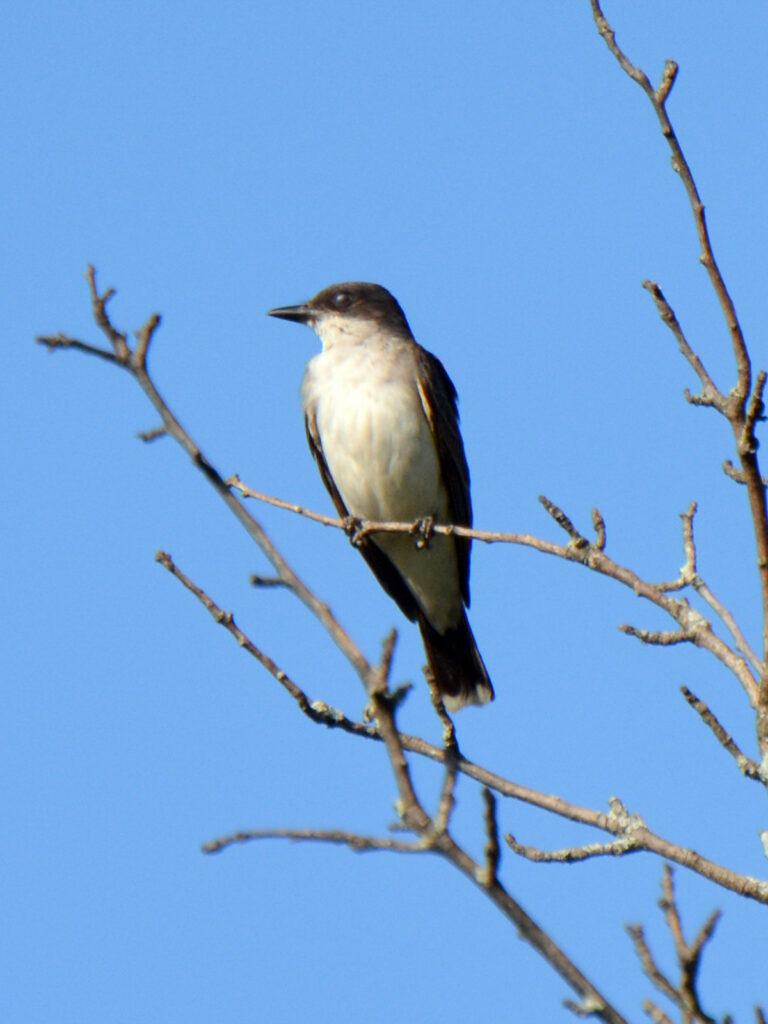
- Learn more:
- Cornell’s All About Birds: Eastern kingbird
- American Bird Conservancy: Bird of the Week
- Birdwatcher’s General Store: Kingbirds attacking hawk
| YR | J | F | M | A | M | J | J | A | S | O | N | D |
| 24 | · | |||||||||||
| 23 | · | · | · | · | · | · | · | · | ||||
| 22 | · | · | · | · | · | · | · | · | · | |||
| 21 | · | · | · | · | · | · | · | · | · | · | · | |
| 20 | · | · | · | · | · | · | · | · | · | · | ||
| 19 | · | · | · | · | · | · | · | · | · | |||
| 18 | · | · | · | · | · | · | · | · | · | |||
| 17 | · | · | · | · | · | · | · | · | · | · | ||
| 16 | · | · | · | · | · | · | · | · | · | |||
| 15 | · | · | · | · | · | 1 | · | · | · | |||
| 14 | · | · | · | · | · | · | · | · | · | |||
| 13 | · | · | · | · | · | · | · | · | · | |||
| 12 | · | · | · | · | · | · | · | · | · | |||
| 11 | · | · | · | · | · | · | · | · | · | · | · | |
| 10 | · | · | · | · | · | · | · | · | · | · | · | · |
| 09 | · | · | · | · | · | · | · | · | · | · | · | · |
| 08 | · | · | · | · | · | · | · | · | · | · | · | · |
| 07 | · | · | · | · | · | · | · | · | · | · | · | · |
| 06 | · | · | · | · | · | · | · | · | · | · | · | · |
| 05 | · | · | · | · | · | · | · | · | · | · | · | · |
| 04 | · | · | · | · | · | · | · | · | · | · | · | · |
| 03 | · | · | · | · | · | · | · | · | · | · | · | · |
| 02 | · | · | · | · | · | · | · | · | · | · | · | · |
| 01 | · | · | · | · | · | · |
Warbling vireo (Vireo gilvus)
This bird was in our yard only a few days, and I can see how we may have missed it in previous years. It pretty much stayed in the bushes. I was glad to have the Merlin Photo ID app, which identified it for me.
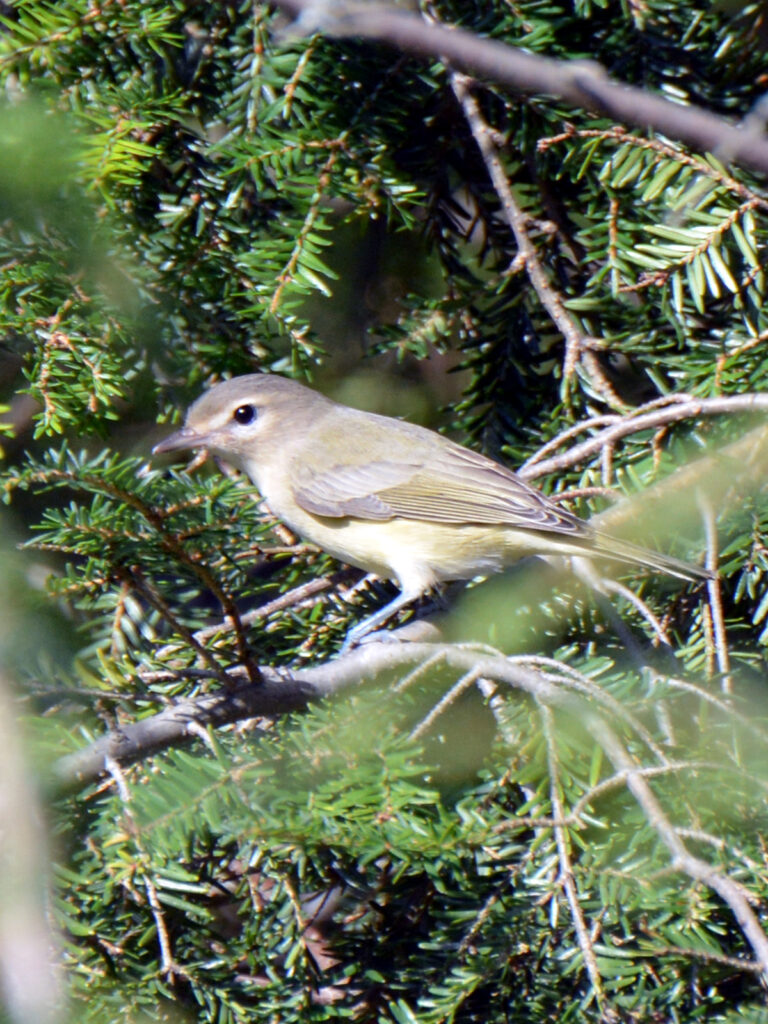
- Learn more:
- Cornell’s All About Birds: Warbling vireo
| YR | J | F | M | A | M | J | J | A | S | O | N | D |
| 24 | · | |||||||||||
| 23 | · | · | · | · | · | 1 | · | · | ||||
| 22 | · | · | · | · | · | · | · | · | · | |||
| 21 | · | · | · | · | · | · | · | · | · | · | · | |
| 20 | · | · | · | · | · | · | · | · | · | · | ||
| 19 | · | · | · | · | · | · | · | · | · | |||
| 18 | · | · | 1 | · | · | · | · | · | · | |||
| 17 | · | · | · | · | · | · | · | · | · | · | ||
| 16 | · | · | · | · | · | · | · | · | · | |||
| 15 | · | · | · | · | · | 1 | · | · | · | |||
| 14 | · | · | · | · | · | · | · | · | · | |||
| 13 | · | · | · | · | · | · | · | · | · | |||
| 12 | · | · | · | · | · | · | · | · | · | |||
| 11 | · | · | · | · | · | · | · | · | · | · | · | |
| 10 | · | · | · | · | · | · | · | · | · | · | · | · |
| 09 | · | · | · | · | · | · | · | · | · | · | · | · |
| 08 | · | · | · | · | · | · | · | · | · | · | · | · |
| 07 | · | · | · | · | · | · | · | · | · | · | · | · |
| 06 | · | · | · | · | · | · | · | · | · | · | · | · |
| 05 | · | · | · | · | · | · | · | · | · | · | · | · |
| 04 | · | · | · | · | · | · | · | · | · | · | · | · |
| 03 | · | · | · | · | · | · | · | · | · | · | · | · |
| 02 | · | · | · | · | · | · | · | · | · | · | · | · |
| 01 | · | · | · | · | · | · |
Red-eyed vireo (Vireo olivaceus)
This little bird seemed to live almost full-time for a few weeks in our pagoda dogwood. We enjoyed having it as a lunch companion every day. Finally, after many years, we got a picture of it in our hemlocks.
To me, its face looks very much like a chipmunk!
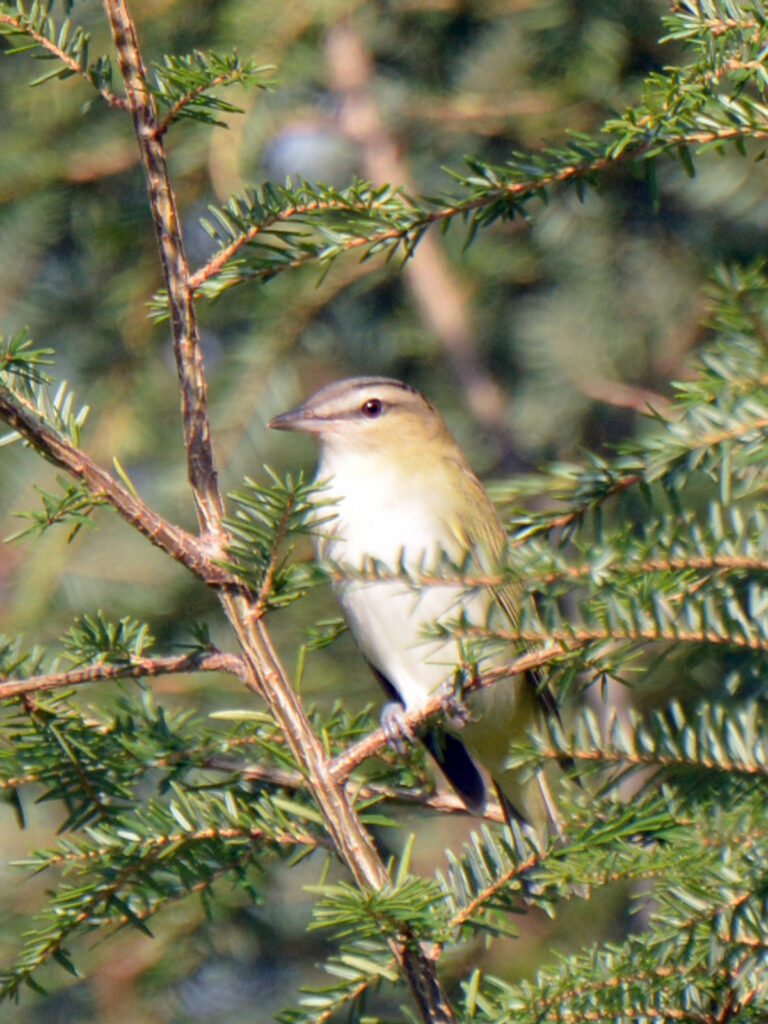
- Learn more:
- Cornell’s All About Birds: Red-eyed vireos
- American Bird Conservancy: Bird of the Week
| YR | J | F | M | A | M | J | J | A | S | O | N | D |
| 24 | · | |||||||||||
| 23 | · | · | · | · | · | · | · | · | ||||
| 22 | · | · | · | · | · | · | · | · | · | |||
| 21 | · | · | · | · | · | · | · | · | · | · | · | |
| 20 | · | · | · | · | · | · | · | · | · | · | ||
| 19 | · | · | · | · | · | · | · | · | · | |||
| 18 | · | · | · | · | · | · | · | · | · | |||
| 17 | · | · | · | · | · | · | · | · | · | · | ||
| 16 | · | · | · | · | · | · | · | · | · | |||
| 15 | · | · | · | · | · | 1 | · | · | · | |||
| 14 | · | · | · | · | · | 1 | 1 | · | · | |||
| 13 | · | · | · | · | · | · | · | · | · | |||
| 12 | · | · | · | · | · | · | · | · | · | |||
| 11 | · | · | · | · | · | · | · | · | · | · | · | |
| 10 | · | · | · | · | · | · | · | · | · | · | · | · |
| 09 | · | · | · | · | · | · | · | 1 | · | · | · | · |
| 08 | · | · | · | · | · | · | · | · | · | · | · | · |
| 07 | · | · | · | · | · | · | · | · | · | · | · | · |
| 06 | · | · | · | · | · | · | · | · | · | · | · | · |
| 05 | · | · | · | · | · | · | · | · | · | · | · | · |
| 04 | · | · | · | · | · | · | · | · | · | · | · | · |
| 03 | · | · | · | · | · | · | · | 1 | · | · | · | · |
| 02 | · | · | · | · | · | · | · | · | · | · | · | · |
| 01 | · | · | · | · | · | · |
Blue jay (Cyanocitta cristata)
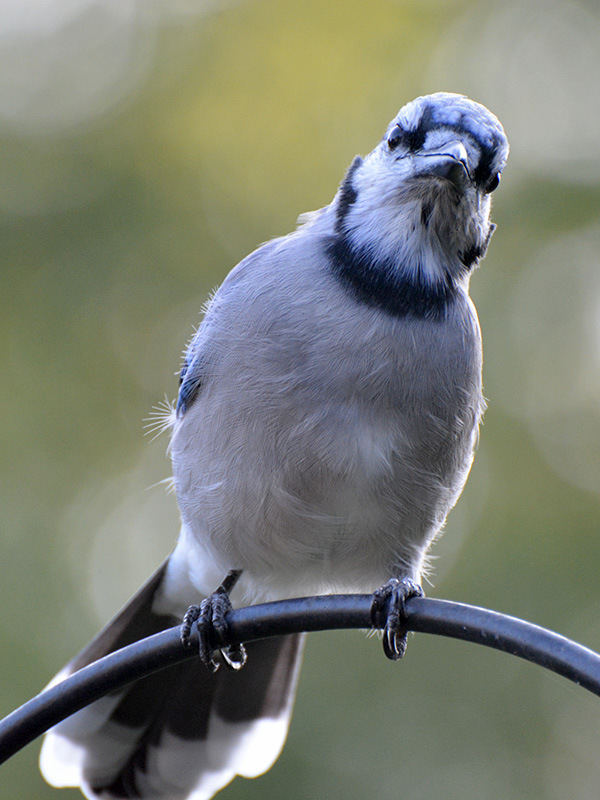
Blue jays are pretty raucous and “in your face.” I like their brashness and feed them peanuts in the winter. In the summer, though, other birds raising their babies get too upset when blue jays are around so I don’t encourage them. They soon learn to come back for peanuts in the fall, though. Some people don’t like them because they think they attack nestlings. They may occasionally, but a Cornell study found only 1% of their stomach contents were other bird parts. (And who are humans to criticize other species, anyway!) I love their variety of odd calls and sounds they make.
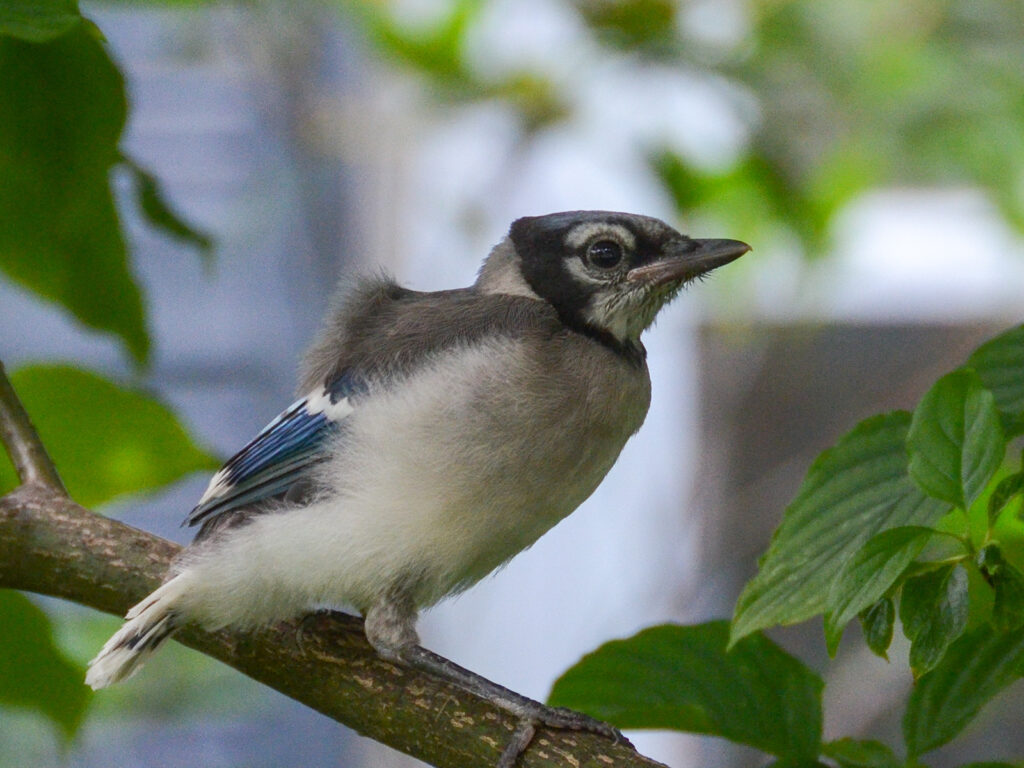
They start out loud from “birth.” This small blue jay baby made its presence known! It looks like it might have recently fledged since its wing feathers aren’t yet out.
- Learn more:
- Cornell’s All About Birds: Blue jays
- American Bird Conservancy: Bird of the Week
| YR | J | F | M | A | M | J | J | A | S | O | N | D |
| 24 | 3 | |||||||||||
| 23 | 5 | 4 | 4 | 3 | 2 | 4 | 5 | 5 | ||||
| 22 | 4 | 3 | 3 | 2 | 2 | 3 | 5 | 6 | 4 | |||
| 21 | 3 | 4 | 4 | 4 | 4 | 2 | 1 | 7 | 5 | 6 | 4 | |
| 20 | 4 | 3 | 3 | 3 | 3 | 4 | 3 | 3 | 4 | 2 | ||
| 19 | 1 | 2 | 2 | 3 | 4 | 3 | 3 | 3 | 2 | |||
| 18 | 3 | 3 | 1 | 1 | 1 | 5 | 4 | 4 | 1 | |||
| 17 | 3 | 3 | 3 | · | 2 | 2 | 4 | 3 | 3 | 6 | ||
| 16 | 4 | 2 | 2 | 5 | 1 | 5 | · | 4 | 4 | |||
| 15 | 2 | 2 | 3 | 1 | · | 4 | 3 | · | · | |||
| 14 | 4 | 4 | 1 | 1 | 4 | 2 | 4 | 3 | 2 | |||
| 13 | 3 | 4 | 2 | 1 | 1 | 3 | 4 | 3 | 4 | |||
| 12 | 2 | 5 | 4 | 3 | 4 | 5 | 6 | 6 | 5 | |||
| 11 | 5 | 4 | 3 | 2 | 2 | 1 | · | 7 | 5 | 6 | 5 | |
| 10 | 4 | 4 | 2 | 4 | 1 | · | · | · | 5 | 4 | 3 | 4 |
| 09 | 5 | 2 | 4 | 3 | 2 | 1 | 1 | 5 | 3 | 2 | 2 | 4 |
| 08 | 3 | 4 | 3 | 2 | 2 | 2 | 2 | 3 | 4 | 3 | 4 | 3 |
| 07 | 1 | 1 | 2 | 4 | 2 | 2 | 1 | 4 | 8 | 5 | 4 | 5 |
| 06 | 4 | 5 | 5 | 4 | 4 | 1 | 3 | 7 | 2 | 4 | 4 | 3 |
| 05 | 4 | 5 | 4 | 6 | 2 | 2 | 2 | 2 | 6 | 4 | 2 | 3 |
| 04 | 3 | 4 | 4 | 5 | 4 | 5 | 5 | 6 | 5 | 3 | 4 | 4 |
| 03 | 4 | 5 | 4 | 4 | 3 | 4 | 5 | 6 | 4 | 3 | 4 | 5 |
| 02 | 4 | 3 | 3 | 6 | 3 | 4 | 2 | 5 | 6 | 4 | 4 | 2 |
| 01 | 3 | 4 | 4 | 3 | 3 | 4 |
American crow (Corvus brachyrhynchos)
Our neighborhood — in fact, all populated areas in CNY — have lots of crows. We don’t. Although we’ve seen a crow every month, we may see one in May one year, one in June another year etc.
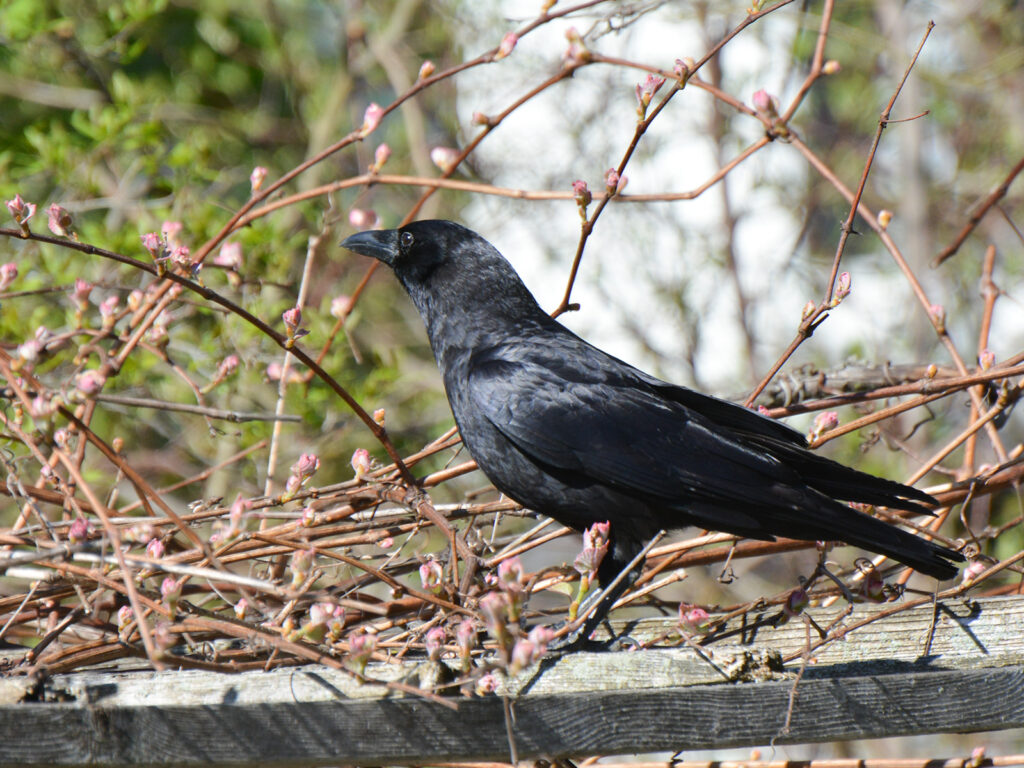
I suspect that, like Canada geese, they don’t like areas where they can’t see around. Our natural landscaping apparently doesn’t feel as safe as lawn. Still, I enjoy watching them when they are here. They’re so intelligent and have such an interesting society. It’s odd to me that people readily accept offensively loud motorcycles roaring up and down the streets as well as the constant roar of power lawn equipment, but demand an end to crows since they’re so loud. (In fact, a neighboring town had crow shoots…) Talk about a disconnect with the natural world!
One disturbing thing, though, is that they will predate on baby birds. One year we saw this up close. A robin had built a nest in our rhododendrons right next to our window, so we had a front row seat. After watching the robin sitting on the nest and spending days feeding its babies, I discovered a crow had taken them! Although it was very sad, I know they’re both native birds, and this is how nature works. (And as I’ve said before, who are humans to criticize other creatures As Mark Twain said, humans are the only creatures to blush — or need to!)
- Learn more:
- Cornell Lab of Ornithology and All About Birds:
- Mass Audubon: Raven, Crow, or Grackle? How to tell the difference
- American Bird Conservancy: Bird of the Week
- Bird Watcher’s General Store: Baby crows calling
| YR | J | F | M | A | M | J | J | A | S | O | N | D |
| 24 | 2 | |||||||||||
| 23 | 6 | 2 | 1 | 1 | 5 | · | 6 | · | ||||
| 22 | 1 | · | 1 | · | · | · | · | · | · | |||
| 21 | 2 | · | · | 1 | · | · | · | · | · | · | · | |
| 20 | · | 1 | 1 | · | · | · | · | 1 | 1 | · | ||
| 19 | · | 2 | 1 | 2 | · | · | · | · | · | |||
| 18 | · | 1 | 1 | · | · | · | · | · | 1 | |||
| 17 | · | 1 | · | · | 2 | · | · | · | 2 | 4 | ||
| 16 | · | · | 3 | · | 1 | · | · | 8 | · | |||
| 15 | · | 1 | 1 | · | · | · | · | · | · | |||
| 14 | · | · | · | · | · | 1 | 2 | · | · | |||
| 13 | 1 | 1 | · | · | · | · | · | 2 | · | |||
| 12 | · | · | · | · | · | · | · | · | · | |||
| 11 | · | 2 | 1 | 1 | 1 | · | · | · | · | · | · | |
| 10 | 1 | · | 1 | 1 | 1 | · | · | · | · | · | · | · |
| 09 | · | · | · | · | · | · | 1 | · | · | · | 1 | · |
| 08 | · | · | · | · | · | · | · | · | · | 1 | 3 | 2 |
| 07 | · | 2 | · | 1 | 1 | · | · | · | · | · | · | · |
| 06 | · | · | 1 | 1 | · | · | · | · | 1 | · | · | · |
| 05 | 2 | 2 | · | · | · | · | · | · | · | · | · | · |
| 04 | · | · | 1 | · | 1 | · | 1 | 1 | · | 1 | · | 1 |
| 03 | 1 | 1 | 2 | · | · | 1 | · | · | · | · | 2 | · |
| 02 | 5 | 6 | 6 | 4 | 4 | 5 | 5 | 3 | 3 | 1 | · | · |
| 01 | 2 | 3 | 2 | · | 1 | 3 |
